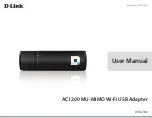
Omni 56K USB Lite
3-8
Specifications and Functional Description
Please refer to the Bellcore Technical Advisory document TR-NWT-000030 for
the exact data format. The above Caller ID scheme applies to the North America
area. Different countries may employ different Caller ID schemes, check if the
scheme used in your country is supported before using the Caller ID feature. For
most other Caller ID schemes, only the Caller telephone number is provided.
Distinctive Ring
Distinctive Ring is a phone service that may be offered by your phone company. Check your phone company
for availability. With this service, you can have several phone numbers assigned to the same phone line. The
phone company sends a different type of ring signal for each phone number being called. The subscriber can
distinguish which number is called by which type of ring is received.
One benefit of this feature is the ability to have three numbers on the same line allowing you to list the three
numbers for voice, data, and fax, respectively. You can then have your fax machine answer only the ring
corresponding to the fax number and have your modem answer only the ring corresponding to the data
number. A voice call is not answered by either fax machine or data modem and it is answered only by
picking up the phone. You can also have the answering machine answer only the voice ring. A more
complicated use is that you can have one number for multiple uses, such as one number for both data and fax.
A ring signal is a composition of repeated on and off states. Different types of rings usually correspond to
different compositions of the "on" part (cadence) of the ring. Your modem can distinguish up to four types of
ring signals and can be commanded to answer or not answer any one of these four types of ring signals.
Following is a list of these four types of ring signals. These are the ring types used in the USA. The
difference among the ring types is the two-second ON part of the ring signal. It comprises a long, double
short, or triple short ring.
S-register S40 bits 3-6 are used for distinctive ring control. Each bit controls the answering of a particular
ring type. Setting a bit to "1" enables answering, setting it to "0" rejects the ring. Note that the ring may still
be heard even if it is not counted as an accepted ring by the modem.
The control relationships between bits 3 to 6 in register S40 and the different ring types are:
Table 3-5 Different Ring Types in Register S40
TYPE
BIT (ON)
RING SEQUENCE
1
3
1.2s or 2s on; 4s off
2
4
0.8s on, 0.4s off, 0.8s on; 4s off
3
5
0.4s on, 0.2s off, 0.4s on, 0.2s off, 0.8s on; 4s off
4
6
0.3s on, 0.2s off, 1s on, 0.2s off, 0.3s on; 4s off
















































